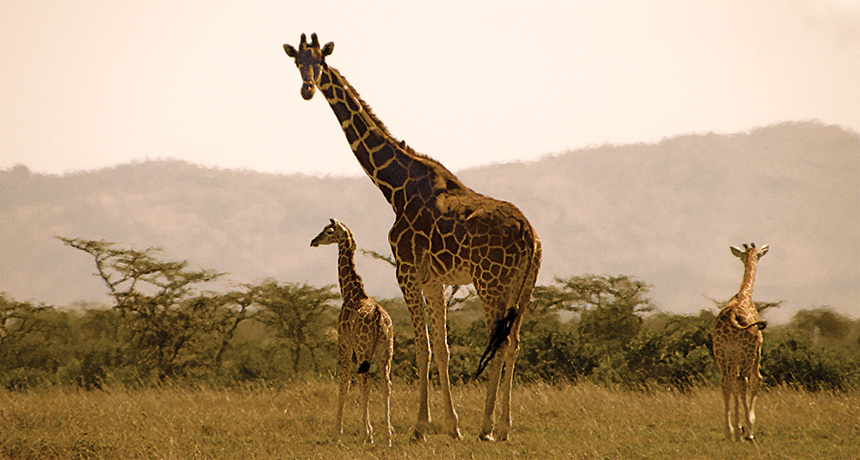Giraffes inherit their spots from mom
The pattern of fur splotches may also indicate how well a calf will be able to survive

Giraffes get their characteristic patterns of spots from mom — but not from their dads, a new study finds.
kimvanderwaal/Flickr (CC BY 2.0)
The mottled patterns that adorn Africa’s tallest creatures are passed down from their mothers, a new study suggests.
A giraffe inherits spots that are similar to those of its mother in two ways. These are the roundness and the smoothness of the spots’ borders. Researchers shared their new findings this October 2 in PeerJ. The splotches’ size and shape also may affect a calf’s chances of surviving in the wild, the team notes.
Giraffes — like tigers, zebras and jaguars — are covered in patterns. These aid in regulating body temperature. They also help signal to other animals that they’re part of the same species. The markings can even act as camouflage. They optically break up the body shapes of animals. That can help them hide from predators.
People “kept asking us ‘Why do giraffes have spots?’ and ‘Do calves inherit their spot patterns?’ ” says Derek Lee. He’s a wildlife biologist at Pennsylvania State University in University Park. He also is principal scientist at the Wild Nature Institute, based in Concord, N.H. “We didn’t have any answers. So we used our data to get them.”
Previously, some scientists had suggested that the patterns of animals’ spots and stripes were random. Others had suspected that environmental factors might influence the spots. Lee and his colleagues, though, suspected there was a hereditary link.
To find out, this team photographed the coats of 31 mother-and-baby giraffe sets between 2012 and 2016. All roamed the East African nation of Tanzania. Computer software analyzed the images. This helped the researchers compare the patterns within each pair, based on 11 traits. These included spot shape, size and color.

Two traits were strikingly similar between a mother and her calf. These were the roundness of the spots and the smoothness of their borders. The team interpreted this as a sign that the calf’s spot patterns were inherited.
The team also wanted to check how well calves’ spots allowed the animals to blend in with their surroundings. This could help them evade predators. So the researchers widened their pool of subjects to 258 calves. Then they attempted to photograph each one six times a year throughout the four years of the study.
The team then ran analyzed their data on these photos mathematically. These analyses allowed the researchers to estimate the likelihood a calf had survived for years. One group of them appeared to have the best chances of survival during the first season of life. These were calves with larger, irregularly shaped spots.
“They’re not suggesting that spots matter for survival, but that the differences in spots matter for survival,” says Hopi Hoekstra. She’s an evolutionary biologist at Harvard University in Cambridge, Mass.
Other researchers now will need to confirm these findings by analyzing the giraffes’ DNA, Lee says. “We’ve just scratched the surface.”







